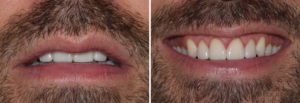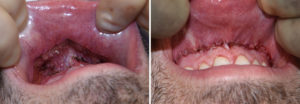The gummy smile is a well known perioral appearance that occurs when too much of the gums (gingiva) shows when smiling. The interpretation of too much gingival show will vary amongst different people and their aesthetic sense. But the general aesthetic standard is that if more than a few millimeters shows when smiling it would be considered excessive.
There are a variety of causes of a gummy smile and can include vertical maxillary excess, hyperactive lip elevators and even a short dental crown length. This leads to a variety of treatment strategies from dental crown lengthening to a maxillary impaction surgery. Selecting the best treatment depends on classifying the degree of gum exposure. If it is just a few millimeters of excess, crown lengthening may be considered. If excessive gum shows with the mouth at rest, maxillary impaction surgery would be best.


This amount is determined by first measuring how much the upper lip elevates. This vertical measurement is taken from the incisal edge of the maxillary incisors when smiling and any tooth exposure when the lip is at rest subtracted. This number is then taken and is the vertical distance the vestibule needs to be lowered. This helps make markings on the alveolar and lip mucosa for the removal of the intervening tissue and the subsequent vestibular shortening.
One additional technique that I find useful in gummy smile surgery is the use of levator quadratus superioris muscle release. (myotomy) Once the mucous is removed the muscle can be directly accessed and released. This adds to the effect of the vestibuloplasty in decreasing upper lip elevation.
Dr. Barry Eppley
Indianapolis, Indiana


